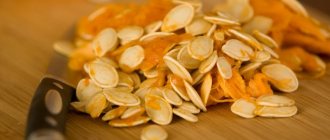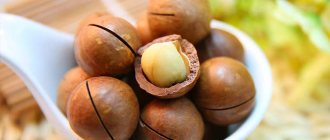Where does it grow and what does it look like?
In nature, the almond tree is most often a pretty shrub or small tree with delicate leaves, somewhat similar to the leaves of eucalyptus. Its maximum height is no more than 6 meters, and this is biologically determined - the roots of the plant are not very developed on the surface, but go deep into any soil. This allows the tree to survive even severe drought, heat and hurricane winds, because most often almonds can be found in mountainous areas.
An almond tree blooming in early spring is a stunning sight - its bare branches, dotted with pink flowers, seem shrouded in a magical haze. The walnut tree bears fruit in mid-summer, and its fruits look like unripe apricots. In Russia, almonds can be found on the Crimean coast, in the Caucasus, and also in the Himalayas. Some amateurs cultivate it in central Russia, but due to severe frosts the plants often freeze out.
Vitamin composition
Almonds have long been valued for their excellent vitamin composition; their fruits contain:
- fatty acid,
- vitamins;
- proteins;
- carotenoids;
- flavonoids;
- alimentary fiber;
- microelements.
The kernels of this tree themselves are quite high in calories - 100 grams of raw nuts contain about 590 kilocalories.
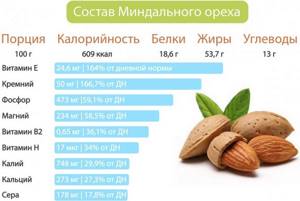
Benefits of almonds for women
Almonds bring invaluable benefits to the fair sex. A large amount of vitamin E contained in the fruits of this tree gives ladies amazing skin, luxurious hair and strong nails. This fact is widely used by manufacturers of skin care products, including almond oil in creams, elixirs, shampoos and shower gels.
Did you know? The aroma of almonds, which is part of perfume compositions, has a stimulating effect on the stronger sex.
Among other things, the oil of this nut will help in the fight against advanced cellulite, for restoring the skin after pregnancy and breastfeeding, and is an excellent emollient. The dietary fiber contained in the fruit is very beneficial for the gastrointestinal tract, and flavonoids improve the removal of toxins from the body and have a rejuvenating effect.
Eating almonds is especially important for women over 50 years of age. It is no secret that during menopause, along with serious changes in hormonal levels, women experience stress associated with the decline of reproductive function. In the fight against emotional instability, depression and insomnia, a few almond kernels a day will be a great help. However, do not overdo it - too many nuts at one time can cause overdose symptoms.

Almonds are also very popular among the fairer sex for weight loss. It is especially promoted by women who take into account the glycemic index of the product when eating. In nuts this indicator is very low, which makes it valuable when drawing up the correct dietary menu. In addition to the fact that almonds help suppress the feeling of hunger for a long time, they also have the ability to significantly improve mood, which is important when losing weight.
What are the benefits of walnuts? The most important things about walnuts
Walnut is a long-lived tree. It begins to bear fruit only 12-15 years after planting. And he has been doing this for about 2 centuries. True, after 80 years in slightly smaller volumes.
In Crimea there is a thousand-year-old specimen that still produces 150 thousand nuts annually.
If you have not seen the plant itself in nature, then it will not be difficult to imagine how a nut grows. The principle is similar to the chestnut: first it blooms, then the flower develops into a fruit in a thick green peel. After ripening, the valves of the fruit open and a brown seed in a hard shell falls to the ground. In this form, the nut reaches the consumer. We essentially eat the kernel of the bone.
100 g is 3-4 large nuts. Let's break them down by composition:
- Proteins – 17 g;
- Fats – 63 g;
- Carbohydrates – 12 g;
- Fiber – 6 g.
Vitamin-mineral structure
The vitamin and mineral structure of walnuts is presented in the table:
| Vitamins | |
| A | 9 mcg |
| RR | 5 mcg |
| TO | 3 mcg |
| WITH | 6 mg |
| E | 4 mg |
| IN 1 | 0.4 mg (30% daily value (DV)) |
| AT 2 | 0.2 mg |
| AT 5 | 0.9 mg |
| AT 6 | 0.8 (45% SN) |
| AT 9 | 79 mcg (20% DV) |
| Macro- and microelements | |
| Potassium | 480 mg (28% DV) |
| Magnesium | 125 mg (30% DV) |
| Calcium | 90 mg |
| Sodium | 7 mg |
| Iron | 2 mg |
| Iodine | 3.5 mcg |
| Fluorine | 690 mcg |
| Zinc | 2.6 mg (20% DV) |
| Manganese | 1.9 mcg (90% DV) |
| Phosphorus | 335 mg (45% DV) |
Amino acids
Amino acids (essential):
- Arginine;
- Tryptophan;
- Phenylalanine;
- Lysine.
Amino acids (nonessential):
- Glutamic acid;
- Aspartic acid;
- Proline;
- Tyrosine.
Calories and glycemic index
The calorie content of walnuts varies depending on the variety and ranges from 680 to 840 kcal. low - only 15 units. Gluten free.
Fatty acid
Walnuts contain omega-6 and omega-9 fatty acids. 50 g of product covers the daily requirement of these substances for the body. The composition also includes saturated and polyunsaturated fatty acids:
- myristic;
- stearic;
- palmitic;
- linoleic;
- linolenic
Important! In terms of the amount of useful substances, ripe nuts are superior to freshly picked ones.
Harm and contraindications for women
However, there is also the other side of the coin - the fruits of the almond tree are very filling and tasty, but you should not consume more than 8-10 kernels per day. Otherwise, the treat will bring some discomfort - a feeling of nausea, headache, dizziness, rapid heartbeat. One of the main contraindications for using the plant is individual intolerance, as well as a tendency to hypertension.
Important! People suffering from a strong heartbeat and in a state of extreme nervous excitement should not eat almonds.
Excessive consumption of almonds can also lead to unnecessary weight gain. In addition, only sweet varieties of the plant can be used for food, while oil is made from bitter varieties.

Is it possible during pregnancy?
Many girls are afraid to eat almonds during pregnancy. However, this product is very useful for both the expectant mother and her baby if the plant does not cause allergic reactions.
Find out how to use almond oil during pregnancy.
One of the most important characteristics of the plant is a large amount of folic acid, which is extremely necessary for the proper development of the baby, the normal formation of the child’s nervous system, as well as his brain and spinal cord. In addition, vitamin A contained in nuts is a good preventative against miscarriages and the so-called jaundice of newborns.
Is it possible with breastfeeding?
But when breastfeeding, eating medicinal nuts is not recommended. Although there is no strict medical prohibition on eating almonds during breastfeeding, you should still treat this with extreme caution.

The main danger is associated with the immature immune system of the newborn, in whom the substances contained in the plant can cause a serious allergic reaction. Therefore, women who are breastfeeding a baby should refrain from eating nuts, both in their pure form and from using products containing almonds.
Composition and calorie content of almonds
There are two types of almonds – sweet and bitter. The first is eaten and used as a medicinal and cosmetic product, the second is used only for medicinal purposes and in cosmetology.
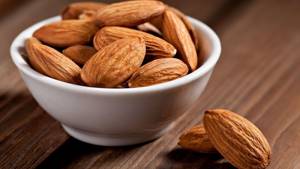
Composition of sweet almonds (per 100 g):
- proteins – 18.6 g;
- fats – 53.7 g;
- carbohydrates – 13 g.
The calorie content of fresh almonds is 575 kcal, fried almonds are 640 kcal.
Almonds are one-third fiber and contain starch, which is beneficial for digestion. The kernels contain 80% omega-9 unsaturated fatty acids and 15% omega-6. These irreplaceable components tend not to be stored in reserve, but actively participate in metabolic processes, cleanse the body, and reduce cholesterol levels.
Important! The glycemic index of unroasted almond kernels is 15 units. Therefore, the nut is recommended as a component of the diet for patients with diabetes and for weight loss.
Chemical composition of almonds:
- vitamin E – preserves youth, promotes the proper functioning of the reproductive system;
- vitamin B2 – normalizes the activity of the nervous system;
- vitamin H – slows down the aging process, maintains healthy skin, hair, nails;
- silicon – strengthens the walls of blood vessels, participates in the formation of the skeletal system;
- magnesium – participates in the metabolism of glucose, protein, nucleic acids;
- phosphorus is an important component of bone tissue, protects teeth from destruction;
- potassium – necessary to maintain proper intracellular pressure;
- calcium is the main building material for bones;
- iron – participates in the production of red blood cells, providing oxygen supply to tissues and organs;
- sulfur - participates in the process of creating new cells and fights pathogenic microorganisms.
Due to their composition, sweet almond kernels, even in small quantities, help regulate metabolic processes in the body, renew cells, promote tissue regeneration, and suppress the development of harmful bacteria.
Application in medicine
It is not surprising that such a healing product is widely used in both folk and official medicine. Nuts are often prescribed as an accompanying remedy in the treatment of diseases of the nervous system, gastritis, high cholesterol, kidney stones, and anemia. The fruits of the almond tree, crushed with a small amount of milk, perfectly treat alopecia.
Did you know? About 40% of all almonds are used to make chocolate.
Almond oil is also very useful - its healing properties for the skin are widely used in the treatment of bedsores in seriously ill patients. In some cases, almonds have anticonvulsant and analgesic effects. The combination of vitamin E with zinc and selenium in raw almonds is considered an excellent remedy for the prevention of cancer.
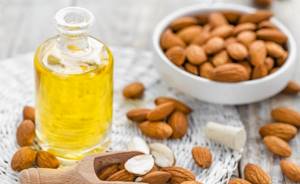
When consumed regularly, this nut brings tangible benefits to the body, since the flavonoids it contains reduce the manifestations of atherosclerosis, and B vitamins, along with magnesium and carnitine, improve cerebral circulation, resulting in improved memory and concentration. This is often used by nutritionists in children's institutions, who recommend including nuts in the menu of modern schoolchildren.
Methods and norms of use
Nut kernels are widely used in cosmetology, food industry, and alternative medicine. Almond oil is in great demand, and is actively used not only in cooking, but also in cosmetology.
Many people wonder how to eat almonds, roasted or raw. In cooking, the kernels are used both raw and fried. Roasted almonds have a higher calorie content, which should be taken into account by overweight people.
In folk medicine, the use of almonds is effective only in combination with medications and only in raw form. Nuts are not effective as a stand-alone medicine.
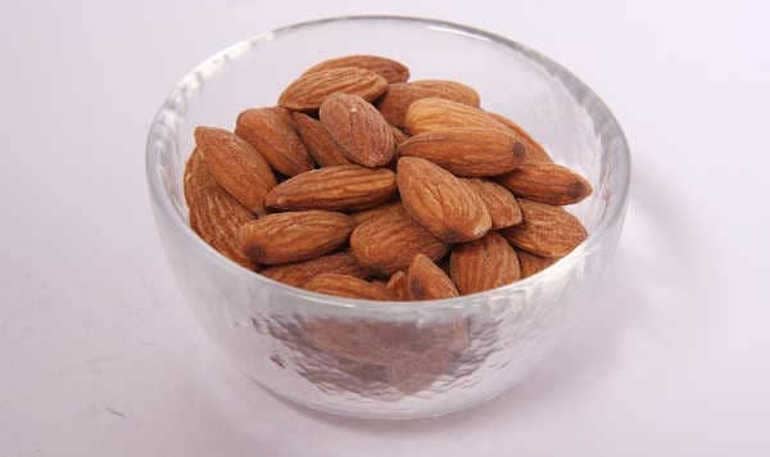
How many almonds should you eat to get the maximum benefit and not cause harm to the body? Doctors and nutritionists recommend adhering to certain standards for nut consumption.
In the absence of contraindications, the recommended daily intake of nuts for adults should be 40-50 grams. For children from three years old - 10-20 grams, for teenage children - 25-30 grams.
For pregnant women and people suffering from diabetes, the daily intake is calculated by a doctor.
Many people have heard about the nutritional properties of nuts, but not everyone knows how to peel almonds correctly. It is best to use a special device for these purposes - a nut cracker.
Soft-shell varieties are easy to peel by hand, while thick shells can be cracked with a hammer, pliers or a garlic press. You can simply remove the brown film from the nuts by dipping them in boiling water for one minute, then rinsing them in cold water. The film then comes off well with light pressure on the nut.
Almond Recipes
Almonds are widely used in cooking. One of the most popular recipes using this nut is the well-known Raffaello candy. They are made using white chocolate, cream, butter, coconut, almonds and sugar. Nuts are often added to the filling of fruit pies, for example it works great paired with peaches or pear.
Important! Unripe almonds should not be eaten as they contain toxic substances and can cause serious health problems.
There are also a number of desserts that are prepared using almond flour - popular macaroons or the fashionable Opera cake. One of the favorite products among vegetarians made from this plant is almond milk. Many desserts are prepared based on it. And the kernels are used to make marzipan, pralines and the beloved almond cookies.

Nuts are often used in salted form, as a traditional snack for beer, and as part of meat, fish and vegetable dishes. Almonds rightfully occupy an important place in the life of a modern woman, and when using it, it is important to remember the main principle - everything is good in moderation. It is then that this plant will become a true friend and assistant in the fight for health and beauty, as well as for a great mood under any life circumstances.
Cooking with almonds
Almonds occupy a place of honor in the culinary arts. Such dishes slow down the aging process and give energy and vigor throughout the day. In shape and size, peach and apricot have a nut inside that is similar to almond, so it is important not to confuse them when preparing the dish.
Almonds are added to confectionery and sweets. Recipes with almonds are very popular among gourmets and supporters of a healthy lifestyle.
Almond milk

Almond milk is popular among housewives and has many beneficial properties and exquisite taste. It is not difficult to prepare; you will need 4 glasses of water and 200 grams of raw nuts.
Almonds should be soaked overnight in water, after which they will swell and become much softer. Place the nuts in a blender bowl, add water and grind. Place the resulting pulp on cheesecloth and squeeze. Add honey to the resulting milk to taste.
Almonds in sugar
To prepare this delicacy you will need:
- granulated sugar - 250 g;
- raw almonds - 300 g;
- purified water - 130 ml.
Pour granulated sugar into boiling water and wait until it dissolves. Pour well-washed and dried almonds into the resulting syrup and cook until the liquid has completely evaporated. Remove the pan from the heat and stir the nuts until completely dry, then put them back on low heat and fry the kernels until brown. Place the prepared almonds on foil and cool.




